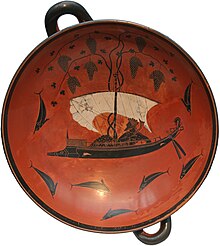
Back Himnos homéricos AST Homer nəğmələri Azerbaijani Homerische Hymnen BAR Kanoù Homeros Breton Himne homèric Catalan Homérské hymny Czech Homeriske hymner Danish Homerische Hymnen German Ομηρικοί Ύμνοι Greek Homeraj himnoj Esperanto
| Homeric Hymns | |
|---|---|
| Attributed to Homer | |
 The Dionysus Cup, a kylix painted by the Athenian Exekias around 530 BCE, possibly showing the narrative of the seventh Homeric Hymn[1] | |
| Composed | c. 7th century BCE – c. 5th century CE |
| Language | Ancient Greek |
| Genre(s) | |
| Published in English | 1624, by George Chapman |
| Metre | Dactylic hexameter |
| Full text | |
The Homeric Hymns (Ancient Greek: Ὁμηρικοὶ ὕμνοι, romanised: Homērikoì húmnoi) are a collection of thirty-three ancient Greek hymns and one epigram.[a] The hymns praise deities of the Greek pantheon and retell mythological stories, often involving a deity's birth, their acceptance among the gods on Mount Olympus, or the establishment of their cult. In antiquity, the hymns were generally, though not universally, attributed to the poet Homer: modern scholarship has established that most date to the seventh and sixth centuries BCE, though some are more recent and the latest, the Hymn to Ares, may have been composed as late as the fifth century CE.
The Homeric Hymns share compositional similarities with the Iliad and the Odyssey, also traditionally attributed to Homer. They share the same artificial literary dialect of Greek, are composed in dactylic hexameter, and make use of short, repeated phrases known as formulae. It is unclear how far writing, as opposed to oral composition, was involved in their creation. They may initially have served as preludes to the recitation of longer poems, and have been performed, at least originally, by singers accompanying themselves on a lyre or another stringed instrument. Performances of the hymns may have taken place at sympotic banquets, religious festivals and royal courts.
There are references to the Homeric Hymns in Greek poetry from around 600 BCE; they appear to have been used as educational texts by the early fifth century BCE, and to have been collected into a single corpus after the third century CE. Their influence on Greek literature and art was relatively small until the third century BCE, when they were used extensively by Alexandrian poets including Callimachus, Theocritus and Apollonius of Rhodes. They were also an influence on Roman poets, such as Lucretius, Catullus, Virgil, Horace and Ovid. In late antiquity (c. 200 – c. 600 CE), they influenced both pagan and Christian literature, and their collection as a corpus probably dates to this period. They were comparatively neglected during the succeeding Byzantine period (that is, until 1453), but continued to be copied in manuscripts of Homeric poetry; all the surviving manuscripts of the hymns date to the fifteenth century. They were also read and emulated widely in fifteenth-century Italy, and indirectly influenced Sandro Botticelli's painting The Birth of Venus.
The Homeric Hymns were first published in print by Demetrios Chalkokondyles in 1488–1489.[b] George Chapman made the first English translation of them in 1624. Part of their text was incorporated, via a 1710 translation by William Congreve, into George Frideric Handel's 1744 musical drama Semele. The rediscovery of the Homeric Hymn to Demeter in 1777 led to a resurgence of European interest in the hymns. In the arts, Johann Wolfgang von Goethe used the Hymn to Demeter as an inspiration for his 1778 melodrama Proserpina. Their textual criticism progressed considerably over the nineteenth century, particularly in German scholarship, though the text continued to present substantial difficulties into the twentieth. The Homeric Hymns were also influential on the English Romantic poets of the early nineteenth century, particularly Leigh Hunt, Thomas Love Peacock and Percy Bysshe Shelley. Later poets to adapt the hymns included Alfred, Lord Tennyson, and Constantine P. Cavafy. Their influence has also been traced in the works of James Joyce, the film Rear Window by Alfred Hitchcock, and the novel Coraline by Neil Gaiman.
- ^ Strauss Clay 2016, pp. 32–34.
Cite error: There are <ref group=lower-alpha> tags or {{efn}} templates on this page, but the references will not show without a {{reflist|group=lower-alpha}} template or {{notelist}} template (see the help page).